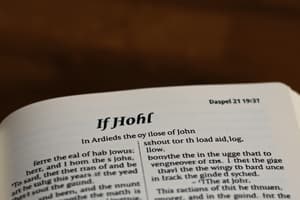Podcast
Questions and Answers
What is a primary emotion explored in John B. Keane's 'Sive'?
What is a primary emotion explored in John B. Keane's 'Sive'?
- Profound Sadness (correct)
- Exuberant Happiness
- Contented Acceptance
- Carefree Ambivalence
Which of the following best describes the form of 'Sive'?
Which of the following best describes the form of 'Sive'?
- Free Verse (correct)
- Rigid Sonnet Structure
- Structured Ballad
- Traditional Rhyming Couplets
How does the poem's use of sensory details impact the reader?
How does the poem's use of sensory details impact the reader?
- It amplifies the emotional impact (correct)
- It provides a humorous backdrop
- It confuses the reader with abstract ideas
- It diminishes the emotional effect
Which concept is most closely associated with the speaker's engagement with the past?
Which concept is most closely associated with the speaker's engagement with the past?
What is the overall 'mood' created in 'Sive'?
What is the overall 'mood' created in 'Sive'?
According to the summary, what do the metaphors and similes within the poem primarily achieve?
According to the summary, what do the metaphors and similes within the poem primarily achieve?
The structure of 'Sive' is best described as mirroring what?
The structure of 'Sive' is best described as mirroring what?
What does 'Sive' seem to be a poignant meditation on?
What does 'Sive' seem to be a poignant meditation on?
Flashcards
What are the core themes of "Sive"?
What are the core themes of "Sive"?
The main idea of the poem, focusing on the impact of loss, the emotions that linger, and the way memory continues to influence the speaker.
How does "Sive" use imagery and language?
How does "Sive" use imagery and language?
The poem uses vivid language and imagery to bring the speaker's emotions to life. This includes descriptions of the world around them, like nature, to help us understand their feelings.
What's special about the structure and form of "Sive"?
What's special about the structure and form of "Sive"?
The poem's structure is flexible, allowing the thoughts and emotions of the speaker to flow freely. It doesn't follow a rigid pattern.
What is the tone and mood of "Sive"?
What is the tone and mood of "Sive"?
Signup and view all the flashcards
How can we interpret "Sive"?
How can we interpret "Sive"?
Signup and view all the flashcards
How does memory affect the speaker in "Sive"?
How does memory affect the speaker in "Sive"?
Signup and view all the flashcards
How does imagery enhance the poem's emotional impact?
How does imagery enhance the poem's emotional impact?
Signup and view all the flashcards
What is the overall experience the poem portrays?
What is the overall experience the poem portrays?
Signup and view all the flashcards
Study Notes
Summary of Key Themes
- The poem "Sive," by John B. Keane, explores themes of loss, longing, and the enduring power of memory.
- The speaker experiences profound sadness and struggles to comprehend the absence of a loved one.
- The poem is a poignant reflection on the passage of time and the lasting impact of loss.
- Keane uses vivid imagery and evocative language to express these central themes.
Imagery and Language
- The poem uses sensory details, including imagery of nature, to intensify the reader's emotional response.
- Vivid descriptions of landscapes, seasons, and weather create a backdrop for the speaker's inner turmoil.
- Metaphors and similes are employed to express profound feelings.
- The speaker frequently compares inner emotions to external phenomena, highlighting the intensity and lasting impact of loss.
Structure and Form
- "Sive" uses free verse, giving the poet flexibility to shape the poem's progression.
- This flexibility allows the poem to reflect the internal and emotional flow of the speaker's thoughts and reflections.
- The poem's structure mirrors the cyclical and unresolved nature of grief.
Tone and Mood
- The poem's dominant tone is sorrow and quiet reflection.
- The mood shifts but retains a somber and melancholic quality, suggesting enduring pain.
- The poem's mood is rooted in a sorrowful loss.
- Variations in sorrow throughout the poem create a strong emotional response in the reader.
Possible Interpretations
- The poem can be seen as a personal elegy for someone close to the speaker, expressing profound sadness and the inability to fully comprehend the lost person's absence.
- The poem's universal themes of loss, longing, and memory connect with a wide range of experiences.
- Keane's language emphasizes the speaker's focus on the past and persistent engagement with memory, contributing to the poem's lingering sorrow.
Specific Examples from the text (possible)
- Analyzing specific lines and passages can delve deeper into imagery, language, and structure, illuminating the themes and the speaker's emotional development.
- Detailed analysis can reveal the speaker's emotional arc throughout the poem.
Studying That Suits You
Use AI to generate personalized quizzes and flashcards to suit your learning preferences.




